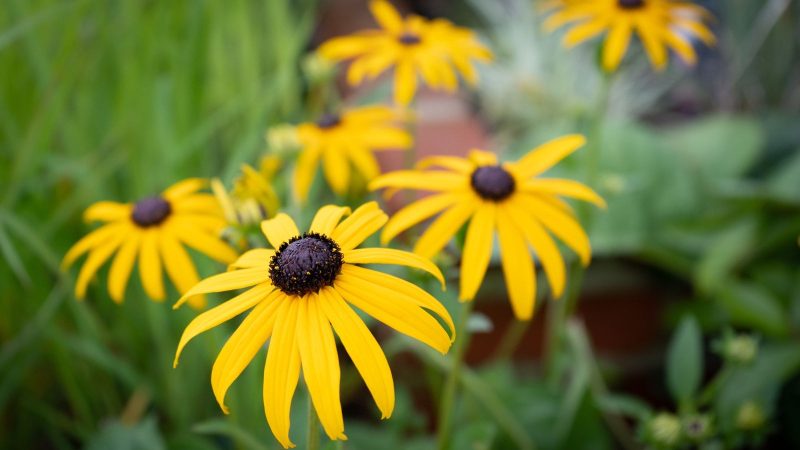Black-eyed Susan is one of the most beloved wildflowers that thrive beautifully in Alabama’s unique climate. With its vibrant yellow petals and distinctive dark brown centers, Black-eyed Susan brings both color and life to gardens across the state. Knowing how to grow Black-eyed Susan in Alabama is essential for gardeners who want to enjoy a flourishing display of these cheerful flowers. This guide provides a thorough and complete overview on planting, growing, and maintaining Black-eyed Susan successfully in Alabama’s environment.
Alabama’s warm summers, mild winters, and rich soils create an ideal setting for Black-eyed Susan to grow robustly. However, to maximize their growth potential and vibrant blooms, gardeners need to tailor their care routines to the local climate and soil conditions. Understanding the nuances of planting time, soil preparation, watering practices, and pest management will allow your Black-eyed Susans to thrive year after year.
Growing Black-eyed Susan in Alabama is a rewarding endeavor, but it demands careful attention and knowledge of the plant’s specific needs within this region. This complete guide will walk you through every stage—from selecting quality seeds to harvesting the full beauty of your garden. By the end, you will be equipped with practical tips and expert advice to cultivate healthy and stunning Black-eyed Susans in your Alabama garden.
Understanding Black-eyed Susan and Its Suitability for Alabama’s Climate

Black-eyed Susan, scientifically known as Rudbeckia hirta, is a native North American wildflower that has become a staple in many gardens due to its resilience and bright appearance. The plant features cheerful golden-yellow petals that surround a prominent dark brown or black cone-shaped center, making it easily recognizable. It is naturally found in prairies, roadsides, and meadows, flourishing in various soil types and conditions.
Alabama’s climate offers warm to hot summers with high humidity levels, alongside mild winters with rare frosts. This climate is conducive to the growth of Black-eyed Susan, as the plant prefers full sun exposure and well-drained soil, conditions often present in Alabama’s landscapes. The plant’s tolerance to heat and drought makes it especially suitable for the summer months, where it can maintain vibrant blooms even under less-than-ideal watering conditions.
One notable advantage of Black-eyed Susan in Alabama is its adaptability to local pests and diseases. While no plant is entirely immune, Black-eyed Susan typically experiences fewer pest issues in Alabama’s environment compared to more delicate flowers. Understanding these climatic and ecological factors helps gardeners choose the right care methods for healthy and abundant flowering.
Choosing the Right Location for Planting Black-eyed Susan in Alabama
Selecting the ideal planting location is a critical step in successfully growing Black-eyed Susan in Alabama. These flowers thrive best in areas that receive ample sunlight, as they require at least six hours of direct sun each day to develop full blooms and sturdy stems. Alabama’s abundant sunshine in spring and summer makes many outdoor spaces suitable, but gardeners must also consider soil drainage and air circulation.
Avoid locations where water tends to pool or the soil remains soggy for long periods, as Black-eyed Susan is prone to root rot in overly wet conditions. Instead, aim for well-drained, moderately fertile soil areas. Slightly elevated beds or slopes can be perfect as they allow excess water to drain naturally. Since Alabama’s humid summers can increase fungal disease risk, planting in spots with good airflow will help reduce moisture buildup on the foliage.
Gardeners in Alabama should also consider protection from harsh afternoon sun if temperatures soar above average, especially in the southern parts of the state. Partial shade during the hottest hours can prevent leaf scorching while still allowing adequate light for flower development.
Preparing Alabama Soil for Optimal Growth of Black-eyed Susan
Proper soil preparation is essential to promote the healthy growth of Black-eyed Susan in Alabama. While the plant is adaptable and can tolerate a range of soil types, it thrives best in loamy or sandy soils that are fertile, well-aerated, and well-drained. Alabama’s native soils vary, often containing clay which may retain too much moisture, so amending soil is usually necessary.
Before planting, it’s beneficial to loosen the soil to a depth of about 12 inches to encourage root penetration and air circulation. Adding organic matter such as compost or aged manure enriches the soil with nutrients and improves texture, balancing moisture retention and drainage. Alabama gardeners should avoid overly rich soil, as excessive nitrogen can lead to lush foliage but fewer flowers.
Testing soil pH is also recommended; Black-eyed Susan prefers slightly acidic to neutral soils with a pH between 6.0 and 7.0. If soil acidity is outside this range, amendments like lime can be applied to raise pH, or sulfur to lower it. Adjusting soil conditions before planting will set the foundation for vigorous growth and prolific blooms.
When and How to Plant Black-eyed Susan Seeds in Alabama
Timing is crucial when planting Black-eyed Susan seeds in Alabama to ensure successful germination and flowering. The best time to sow seeds outdoors is in early spring, once the danger of hard frost has passed, usually from late March to early April. This timing allows plants to establish before the intense heat and humidity of Alabama summers arrive.
Black-eyed Susan seeds can also be started indoors 6 to 8 weeks before the last expected frost to get a head start on the growing season. Indoor seedlings should be transplanted carefully into the garden after they develop a few sets of true leaves and the weather stabilizes.
Planting seeds directly into the soil requires lightly raking the prepared bed to create a fine seedbed. Scatter seeds evenly and cover them with a thin layer of soil, about ¼ inch deep, as too much soil can inhibit germination. Consistent moisture is key during this period, so watering gently to keep the soil damp but not waterlogged supports sprouting.
Watering Practices for Black-eyed Susan in Alabama’s Climate
Water management plays a pivotal role in nurturing Black-eyed Susan plants in Alabama’s climate. While these flowers are fairly drought-tolerant once established, consistent watering is important during their initial growth stages to ensure healthy root development.
Alabama’s hot and humid summers mean that natural rainfall may suffice during certain periods. However, during extended dry spells, supplemental watering becomes necessary. It’s important to water deeply but infrequently, encouraging roots to grow downward and enhancing drought resilience. Overwatering should be avoided, as excess moisture can promote fungal diseases common in Alabama’s humid conditions.
Early morning watering is ideal, as it allows foliage to dry throughout the day, reducing the chance of fungal infections. Mulching around the plants helps conserve soil moisture and keeps roots cool during Alabama’s summer heat, further supporting healthy growth.
Fertilization and Nutrient Management for Black-eyed Susan in Alabama
While Black-eyed Susan is not a heavy feeder, providing appropriate nutrients can boost flower production and plant vigor in Alabama gardens. Over-fertilization, especially with nitrogen-rich fertilizers, should be avoided because it tends to produce excessive leafy growth at the expense of blooms.
A balanced, slow-release fertilizer applied at the beginning of the growing season can supply essential nutrients gradually. Organic options, such as compost tea or well-rotted manure, also work well in Alabama’s soil and help improve soil structure and microbial activity.
Supplemental feeding mid-season may benefit plants that appear weak or are grown in poor soil. However, gardeners should observe the plants carefully to avoid nutrient burn or imbalances. Regular soil testing can help determine if specific amendments are necessary, ensuring that fertilization supports robust flowering without negative side effects.
Common Pests and Diseases Affecting Black-eyed Susan in Alabama
Although Black-eyed Susan is relatively resistant to many pests, Alabama gardeners should still be vigilant against certain insects and diseases that can impact plant health. The humid conditions common to Alabama summers can promote fungal issues like powdery mildew and leaf spot, which manifest as white powdery coating or dark lesions on leaves.
To minimize disease risk, adequate spacing and good air circulation around plants are essential. Removing and disposing of infected foliage can help control outbreaks early. Fungicides may be used if necessary, but natural preventive measures are preferred.
In terms of pests, aphids and caterpillars sometimes feed on Black-eyed Susan foliage and blooms. These insects can weaken plants if infestations become severe. Introducing beneficial insects such as ladybugs or using insecticidal soaps offers environmentally friendly control methods suited for Alabama gardens.
Pruning and Deadheading to Promote Continuous Blooming in Alabama Gardens
Pruning and deadheading are vital techniques to extend the blooming period of Black-eyed Susan in Alabama’s warm climate. Removing spent flowers encourages the plant to produce new buds rather than setting seed too early, thus prolonging its ornamental display.
Regularly pinching back stems can also help maintain a bushier, more compact shape that resists wind damage during Alabama’s stormy periods. By pruning the plants after the first flush of flowers, gardeners stimulate a second bloom cycle, which is particularly rewarding in regions like Alabama where the growing season is long.
In late fall, after the last blooms fade, cutting plants back to the ground helps prepare them for winter dormancy. This practice reduces disease risk and encourages healthy regrowth the following spring.
Propagating Black-eyed Susan for Alabama Gardens
Propagation of Black-eyed Susan is straightforward and can be done through seed sowing or division. Collecting seeds in late summer or early fall allows gardeners to plant new flowers the next season, ensuring a continuous supply for Alabama gardens.
Division of mature clumps can rejuvenate older plants and expand garden coverage. This process is best done in early spring or late fall when plants are dormant or less actively growing. Carefully digging up the root clumps and separating them into smaller sections before replanting helps maintain plant health and vigor.
Propagation is an excellent way to maintain genetic diversity and encourage new growth in different parts of your Alabama garden, enhancing both resilience and floral display.
Incorporating Black-eyed Susan into Alabama Garden Designs
Beyond its individual beauty, Black-eyed Susan can be effectively incorporated into various garden styles common in Alabama. It pairs wonderfully with native grasses, coneflowers, and other wildflowers to create naturalistic or meadow-style landscapes.
The plant’s bright yellow blooms provide striking contrast against green foliage and complement darker colored plants. It is often used in border plantings, pollinator gardens, and along pathways to add bursts of color and attract beneficial wildlife.
Gardeners in Alabama also appreciate Black-eyed Susan’s ability to thrive with minimal maintenance, making it suitable for both formal and informal garden designs. Its long-lasting blooms provide aesthetic value from late spring through fall, enriching Alabama gardens with continuous color.
Seasonal Care and Overwintering Black-eyed Susan in Alabama
Though Black-eyed Susan is a hardy perennial in many parts of the U.S., its behavior in Alabama’s mild winters can vary. In some regions of the state, it behaves like a short-lived perennial or even a biennial, often reseeding itself to maintain population.
During winter, it is helpful to mulch around the base of the plants to protect roots from temperature fluctuations and conserve moisture. Alabama’s relatively mild winter rarely causes severe damage, but providing this extra layer can enhance plant survival.
In early spring, removing old mulch and any dead foliage clears the way for new growth. This seasonal maintenance is key to ensuring vigorous flowering and healthy plants throughout the growing season.
Troubleshooting Common Issues When Growing Black-eyed Susan in Alabama
Despite their hardiness, gardeners may encounter some challenges when growing Black-eyed Susan in Alabama. Poor flowering often results from planting in shady locations or over-fertilizing with nitrogen. Adjusting light conditions or modifying fertilization can often solve these problems.
Wilting or yellowing leaves might indicate overwatering or poor drainage, common pitfalls in Alabama’s humid climate. Improving soil structure or adjusting watering schedules can revive struggling plants.
If pest or disease problems persist, evaluating environmental conditions such as humidity, airflow, and plant spacing can help reduce outbreaks. Timely intervention and preventive practices keep Black-eyed Susan thriving with minimal stress.
FAQ about How to Grow Black-eyed Susan in Alabama
What is the best time to plant Black-eyed Susan in Alabama?
The best time to plant Black-eyed Susan in Alabama is early spring, after the last frost, typically from late March to early April. This timing allows the plants to establish before the hot summer months.
Can Black-eyed Susan tolerate Alabama’s humid climate?
Yes, Black-eyed Susan is well-suited to Alabama’s warm and humid climate. It thrives in full sun and well-drained soil but requires good airflow to prevent fungal diseases common in humid conditions.
How often should I water Black-eyed Susan in Alabama?
Black-eyed Susan needs regular watering during the initial growth phase, but once established, it is fairly drought tolerant. Deep watering once or twice a week is usually sufficient, depending on rainfall.
What soil conditions does Black-eyed Susan prefer in Alabama?
Black-eyed Susan grows best in well-drained, loamy or sandy soil with a slightly acidic to neutral pH (6.0 to 7.0). Amending Alabama’s clay soils with organic matter improves growth.
How do I prevent pests and diseases on Black-eyed Susan?
Maintaining proper spacing for airflow, watering at the base early in the day, removing infected leaves, and encouraging beneficial insects helps minimize pests and diseases on Black-eyed Susan in Alabama.
Can I propagate Black-eyed Susan from seeds in Alabama?
Yes, Black-eyed Susan easily propagates from seeds. Collect seeds in late summer or sow fresh seeds in early spring to grow new plants successfully in Alabama gardens.
Conclusion
Growing Black-eyed Susan in Alabama is a gratifying experience that rewards gardeners with bright, sunny blooms and a lively garden atmosphere. By understanding Alabama’s specific climate and soil conditions and applying tailored planting and care techniques, anyone can cultivate healthy and beautiful Black-eyed Susans.
From choosing the right location and preparing the soil to managing water, nutrients, pests, and seasonal care, this comprehensive guide covers every essential step for success. Whether you are an experienced gardener or a beginner, following these insights will help your Black-eyed Susans flourish and add enduring charm to your Alabama landscape.
With patience and attention to detail, Black-eyed Susan will become a shining highlight of your garden, attracting pollinators and brightening your outdoor space year after year.






